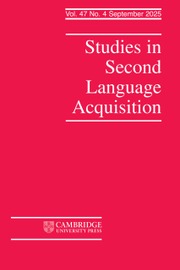Article contents
OUTPUT, INPUT ENHANCEMENT, AND THE NOTICING HYPOTHESIS
An Experimental Study on ESL Relativization
Published online by Cambridge University Press: 28 October 2002
Extract
This study investigates the potentially facilitative effects of internal and external attention-drawing devices—output and visual input enhancement—on the acquisition of English relativization by adult English as a second language (ESL) learners. Specifically, the study addresses: (a) whether the act of producing output promotes noticing of formal elements in the target language (TL) input and affects subsequent learning of the form; and (b) whether such output- induced noticing and learning, if any, would be the same as that effected by visual input enhancement designed to draw learners' attention to problematic form features in the input. These questions were examined in a controlled experimental study in which the requirements of output and exposure to enhanced input were systematically varied. A computer-assisted reconstruction and reading task was used as the vehicle of presentation of the target input materials. The major findings are: (a) Those engaged in output-input activities outperformed those exposed to the same input for the sole purpose of comprehension in learning gains; (b) those who received visual input enhancement failed to show measurable gains in learning, despite the documented positive impact of enhancement on the noticing of the target form items in the input; and (c) in view of the above, no support was found for the hypothesis that the effect of input enhancement was comparable to that of output. The subsequent discussion centers on reexamining the construct of noticing and argues for the need to consider levels and types of processing in order to account for how sensory detection can lead to learning.
Information
- Type
- Research Article
- Information
- Copyright
- © 2002 Cambridge University Press
- 258
- Cited by

